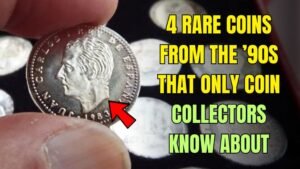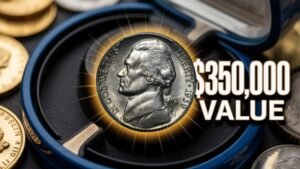Are you a fan of coin collecting, or do you have some old change tucked away from the 1990s? You might be sitting on a fortune without even knowing it. The 1990s were a time when the U.S. Mint produced billions of everyday coins, but a few slipped through with special mistakes, low production numbers, or unique designs. These rare finds from that decade can turn a simple penny or dollar into a collector’s dream, fetching prices from hundreds to tens of thousands of dollars.
What Makes 1990s Coins So Valuable Today?
The 1990s marked a shift in U.S. coin production. With rising interest in errors and commemorative issues, the Mint experimented more, leading to accidental rarities. Coins from this era often look ordinary at first glance, but tiny details like spacing on letters or special mint marks can skyrocket their worth. Factors like low mintage (how many were made), historical ties, and condition play huge roles. For instance, a coin in mint state—meaning it’s almost perfect—can be worth 10 times more than a worn one. Collectors use grading services like PCGS or NGC to certify quality, which boosts resale value. If you’re checking your jars of loose change, look for these four gems. They could be worth a check with a local dealer or online auction site.
Why Hunt for Rare Coins in Everyday Change?
Hunting coins from the ’90s is exciting because they’re common enough to find in circulation but rare in their special forms. Unlike older classics like the 1909-S VDB penny, these are modern and relatable. Plus, with inflation and collector demand rising, values have climbed steadily. A quick inspection with a magnifying glass could reveal a winner—saving you from tossing out a potential payday.
1. Double-Denomination Coins from 1990-1999: A Minting Mix-Up Masterpiece
Imagine a coin that’s confused about its own identity—one side says it’s a penny, the other claims it’s a dime. That’s the magic (or mishap) of double-denomination coins from the 1990s. These happen when the Mint’s machines strike one coin’s design over another during production. Common examples include a Lincoln cent stamped over a Jefferson nickel (creating a “6-cent” oddity) or a Roosevelt dime layered on a penny (making an “11-cent” freak).
How to Spot These Rare Errors
The error is obvious once you know: mismatched edges, off-center designs, or blended dates. But they’re sneaky because they blend into pocket change. Experts believe only 25 to 50 of each type exist, thanks to tight quality controls catching most mistakes.
Current Values and Auction Highlights
Even in average condition, these fetch big bucks. A 1990 “11-cent” version recently sold for about $2,400 on eBay. Higher grades can push prices over $5,000. If you find one, don’t clean it—handle with gloves to preserve the surface.
2. 1992 Close AM Lincoln Memorial Cents: The Subtle Spacing Secret
Pennies are the most common coin, but the 1992 Close AM variety is a unicorn. On the reverse side, the letters “A” and “M” in “AMERICA” are unusually close together—almost touching—due to a design tweak meant for 1993 that jumped the gun. This affects both the Philadelphia (no mint mark) and Denver (D-marked) versions. Over 4 billion regular 1992 pennies were made, but the Close AM ones? A tiny fraction that collectors cherish.
Identifying the Close AM Difference
Grab a magnifying glass: In normal pennies, there’s a clear gap between A and M (about the width of the letter “C”). In the rare Close AM, it’s tighter, like the A is cozying up to the M. It’s tricky without tools, so compare to images online.
Why They’re Worth a Fortune
Worn examples start at $1,000, but uncirculated ones in top shape have sold for $20,000 or more at auctions. The scarcity drives the hype—fewer than a few hundred are known.
3. 1995-W Silver Eagle Proof Dollar: West Point’s Shiny Surprise
The American Silver Eagle series is a hit among investors and collectors, but the 1995-W proof stands out. The “W” mint mark shows it came from the West Point Mint, and it was the first year for this mark on proofs—special coins with mirror-like finishes for display. Only 30,125 were produced, mostly in collector sets.
Key Features and Rarity Factors
These one-dollar coins feature Lady Liberty draped in a flag on the front and a soaring eagle on the back. The proof quality means crisp details and reflective surfaces. Low numbers make it scarcer than most Silver Eagles.
Market Prices and Record Sales
Entry-level prices hover around $2,000 for circulated, but proofs in gem condition? One fetched $86,655 in 2013, and another $55,550 recently. Demand from precious metal fans keeps values climbing.
4. 1997-W Jackie Robinson Commemorative Gold Five-Dollar: A Historic Home Run
Celebrating baseball legend Jackie Robinson, who shattered Major League Baseball’s color barrier in 1947, this gold coin is more than metal—it’s a piece of civil rights history. The obverse shows Robinson stealing home, with the reverse honoring his legacy. Minted at West Point (W mark), it was part of a 1997 set, but sales flopped.
Production Details and Low Sales Story
Planners aimed for 100,000 coins, but only 5,174 sold—leaving extras melted down. That tiny survival rate makes it one of the rarest modern U.S. coins.
Value Trends and Collector Appeal
Originally $180, these now average $3,000 to $5,000 in proof condition. PCGS ranks it as the 24th most valuable post-1965 U.S. coin. History buffs and sports fans drive the premiums.
Glossary of Coin Collecting Terms
Coin jargon can confuse beginners. Here’s a simple table breaking down tough words from this article:
| Term | Simple Explanation |
|---|---|
| Numismatist | A person who collects and studies coins as a hobby or job. |
| Mintage | The total number of coins produced in a specific year or design. |
| Mint Mark | A tiny letter (like D for Denver or W for West Point) showing where the coin was made. |
| Proof Coin | A special coin struck for collectors with extra sharp details and shiny surfaces. |
| Uncirculated | A coin that’s never been used in daily spending, so it’s in perfect shape. |
| Double-Denomination | A rare error where two different coin values are stamped on one piece. |
| Close AM | A design flaw where letters “A” and “M” on a penny are too close together. |
Use this quick reference to sound like a pro next time you chat with a dealer.
Tips for Starting Your 1990s Coin Hunt
Ready to dig in? Start with family heirlooms or bank rolls of pennies. Use apps like PCGS CoinFacts for verification. Join forums on Reddit’s r/coins or attend local shows. Always authenticate big finds with experts to avoid fakes. Remember, patience pays—many collectors strike gold after years of searching.
Conclusion
The 1990s gave us more than grunge music and dial-up internet; they delivered these four extraordinary coins that blend rarity, history, and error magic into potential windfalls. From the quirky double-denomination mishaps to the poignant Jackie Robinson tribute, each tells a story worth far more than face value. Whether you’re dreaming of that $80,000 Silver Eagle sale or just curious about your change jar, exploring these hidden gems can spark a lifelong passion for numismatics




